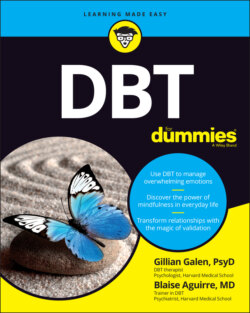Читать книгу DBT For Dummies - Gillian Galen - Страница 23
Types of dysregulation
ОглавлениеOver time, people who were emotionally sensitive and who didn’t have the skills to manage difficult situations and relationships in their lives would develop enduring difficulties in regulating five areas of daily experience. The term used by therapists for an inability to regulate is dysregulation, and so people with conditions like BPD had the following five areas of dysregulation, a conceptualization originally described by Dr. Linehan in 1993:
Emotion dysregulation: Emotion dysregulation is the inability to flexibly respond to and manage one’s feelings in the context of emotional responses that are highly reactive. Typically, these are brief episodes, lasting a few hours, but they feel overwhelming. Although a person with BPD might have difficulty regulating all emotions, irritability and anger are specified in the Diagnostic and Statistical Manual of Mental Disorders (DSM), which is the manual that mental health experts use to classify psychiatric conditions.
Interpersonal dysregulation: Interpersonal dysregulation is characterized by a fear, whether real or imagined, that the person with BPD will be abandoned by those closest to them. In this context, the person with BPD will then become desperate to prevent the abandonment from occurring and will then behave in ways to stop it from happening. These ways will often appear to be extreme to the person on the receiving end of the behavior, and at times can be the reason why that person no longer wants to have anything to do with the person with BPD.Another hallmark of this is that people with BPD tend to develop intense relationships with others, and these are characterized by extremes of, at times, idealizing the other person and then, at other times, devaluing the other person. These fluctuations can happen very quickly and leave the other person feeling bewildered.
Self-dysregulation. Self-dysregulation is characterized by having an unstable sense of self and the experience of feeling empty inside. People with BPD can have a very difficult time defining themselves in terms of who they are as people, what their values are, and what their long-term goals and life direction are. At times they look to others and others’ behavior, and try to copy it in order to fit in, but they often recognize that when they simply behave differently, it does not always feel authentic. Another aspect of self-dysregulation is the experience of emptiness, which is an intense feeling of disconnectedness, aloneness, and feeling misunderstood.
Cognitive dysregulation: Cognitive dysregulation is characterized by relatively brief episodes of paranoid thinking, and this is particularly true during periods of stress. This means that when the person with BPD has high stress levels, they can begin to imagine that others are intentionally out to get them, even when there is no evidence that this is true. People with BPD can also experience dissociation, which is the feeling or thought that they are not real or that the rest of the world is not real.
Behavioral dysregulation: Behavioral dysregulation in people with BPD is characterized by extreme, sometimes impulsive, and at times dangerous behaviors. These behaviors are often used as a way to deal with intense and unbearable emotions, and can include self-injurious behaviors, such as cutting and suicide attempts. Other such behaviors include eating behaviors, such as binge eating, substance use as a way to fit in or self-medicate, dangerous sexual behaviors as a way to feel connected, and dangerous driving or excessive spending as ways to feel a rush of positive emotions.
